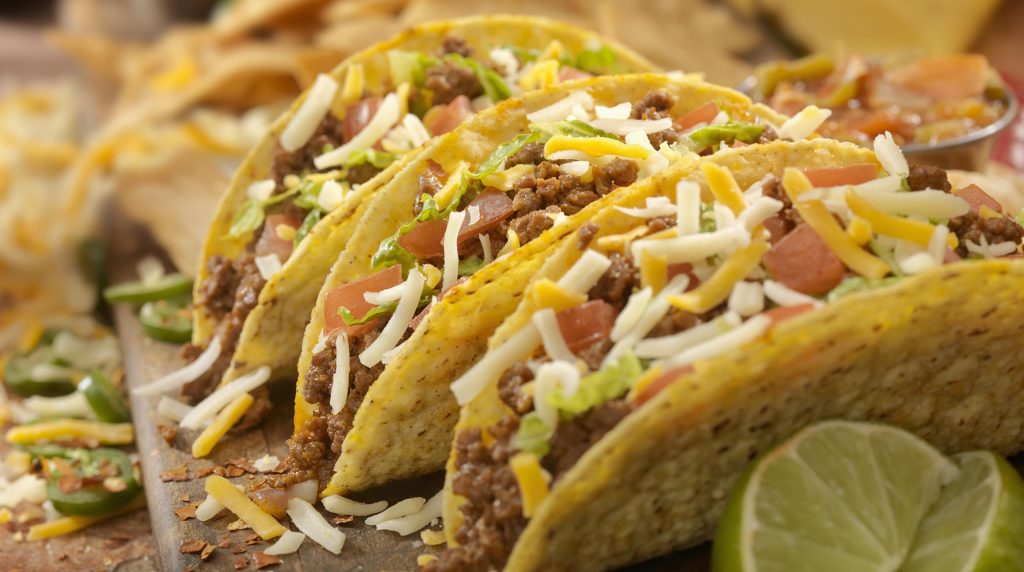The History of the Taco
We eat 4.5 billion tacos a year. We eat them on Tuesdays, but we’ll say yes any other day of the week too. We’ve combined them with the internet’s favorite animal—cats—to come up with the world’s cutest palindrome. In other words: We can’t get enough of ’em.

But what makes a taco a taco? Who invented tacos? Where did tacos originate?
“Every taco tells a story about the land, the people that made it, migration, and immigration,” says Maite Gómez-Rejón, cultural historian and founder of ArtBites: Cooking Art History, which offers classes, recipes, and more. (She also co-curated the inaugural exhibit for LA Plaza Cocina, the first museum dedicated to Mexican food.) Read on to find out more.
What Does the Word “Taco” Mean?
What Does the Word “Taco” Mean?
While the concept of the taco has been around for millennia, the word taco dates to the 19th century. In its debut reference appearance—the official dictionary of the Spanish language, Real Academia Española—it’s defined as a peg or plug.
“Miners in Mexico used to plug holes with dynamite sticks consisting of gunpowder wrapped in paper, called tacos,” Gómez-Rejón says. “The spicy salsa on an envuelto, or wrap, made the food feel like dynamite. So lo and behold, the taco as we know it was born.” The first tacos called so by name were tacos de minero (miners’ tacos), consisting of meat, bacon, and potatoes, she says.”
The Origin of the Modern Taco
The Origin of the Modern Taco
We can’t attribute the history of tacos to an exact date or really know who made the first taco, Gómez-Rejón says. Even the first cookbook published in Mexico, 1831’s El Cocinero Mexicano, doesn’t mention tacos or tortillas. While the cookbook became known for taking a strong nationalist stance and delineating native Mexican food from colonial influence, that influence still reigned strong at the time.
But in the years preceding the Mexican Revolution, which began in 1910, questions emerged about what it meant to be truly Mexicano—and, not coincidentally, the first taquerias opened in Mexico City. “The first taco recipes in print date to the late 1930s, when Josefina Velázquez de León, a cooking instructor and author who traveled the country collecting regional recipes from female home cooks, documented what Mexicans across the country really ate,” Gómez-Rejón says. “So we don’t see a published taco recipe until the 1930s, but people in Mexico had been eating them, and all of their regional variations, for centuries.”
Where Did Tacos Originate?
Where Did Tacos Originate?
Your instinct is probably correct here: Tacos as we know them originated in Mexico, and they came to the United States via the large number of Mexicans who migrated during and in the years preceding the Mexican Revolution. “For years, Mexican food was seen as lower-class street food associated with female tamal vendors in Los Angeles, or chili prepared and served by the Chili Queens in San Antonio,” Gómez-Rejón says. “Mexico was considered dangerous, but tasting Mexican food from these women gave Americans a taste of the exotic.” In time, the Mexican-American taco became an adaptation of the Mexican taco using locally available ingredients such as hamburger meat, yellow cheese, and green bell pepper.
What Makes a Taco a Taco?
What Makes a Taco a Taco?
“Every culture has some sort of dish consisting of a filling wrapped in dough,” says Gómez-Rejón. South America has its empanadas; the Middle East has stuffed pitas; Europe has its crepes and blintzes. So what differentiates a taco from those savory bites? “What makes a taco a taco is the tortilla,” she says. Pair that tortilla with a filling—traditionally meat, fish, beans, and vegetables in varying combinations—and you’ve got a taco.
From there, what makes a taco a taco varies by the aficionado. Some say a taco can’t be called a taco unless the tortilla is made of corn (more on that below). Gómez-Rejón says she believes that “a taco isn’t a taco without a really good salsa.” As for what ingredients are in taco seasoning—whether made from scratch or picked up premade—look to paprika, chili powder, cumin, salt, onion powder, and a few other easy-to-find flavorings.
What Different Types of Tacos Are There?
What Different Types of Tacos Are There?
“Judging by dinner menus across the country, tacos are practically limitless both in fillings and in styles. Standard taco fillings include beef, chicken, fish, and chorizo, a seasoned ground pork sausage. While you can use different grains for the tortilla, the original tortilla was made of corn—“the life force of the Americas,” says Gómez-Rejón. The indigenous tortilla is soft and made with nixtamalized corn, an ancient process where ripe corn grains are soaked in an alkalized solution of water and calcium hydroxide, which heightens the grain’s nutritional value.
“The flour tortilla emerged post-conquest with the introduction of wheat, and today there are many tortilla variations using alternative flours,” Gómez-Rejón says. “Oat and almond tortillas are actually quite delicious.”
The hard taco shell was marketed to the masses by a fast-food chain in California in the 1950s. While hard shells had been made by Mexicans before, they were always fried to order so as to guarantee freshness. “In the fast-paced U.S., this was not going to fly,” Gómez-Rejón says. Frying to order took too long, so the chain’s founder marketed the pre-fried shells—making ersatz “Mexican food” available to Americans of any ethnicity regardless of proximity to Mexican American communities.
But this has changed. “Immigrants’ culinary traditions have been embraced in the U.S., and taco trucks and taquerias selling everything from tacos al pastor to barbacoa and carnitas—similar to what you can find anywhere in Mexico—have popped up in cities all over the country,” Gómez-Rejón says. “Today you can find tacos with Asian and Polish flavors and every flavor in between. The taco has and will continue to evolve.”
Popular Types of Tacos and Regional Differences
While taco styles and fillings are limited only to the human imagination (chocolate tacos, anyone?), there are a handful of varieties to keep your eyes open for, including:
Al Pastor
Featuring spit-grilled boneless pork, this regional Mexican taco has become popular in the U.S. “Tacos al pastor were invented by second-generation Lebanese Mexicans in the 1960s—a variation of tacos arabes made by the original wave of immigrants of the 1920s, but using pork instead of lamb, and adding pineapple,” Gómez-Rejón says. “It is essentially a variation of a shawarma with tortilla instead of pita.”
Barbacoa and Barbecue
You’ll find this all the way across the country, particularly in the South, Texas, and California. We owe its origins to the Caribbean, where Spanish conquistadors saw how Indigenous Taínos cooked food using a stick framework called a barbacoa, according to Serious Eats. In Mexico and what is now Texas, the technique came to mean cooking in a covered earthen oven to achieve a roasted, slightly smoky flavor. In other parts of the U.S., barbacoa involves using a steamer or pressure cooker.
Carne Asada
With a carne asada taco, flap steak from the short loin section of a cow is marinated in citrus juice, cumin, and other spices before being grilled, according to Thrillist. The meat is chewy and flavorful, and it’s usually cut into small chunks.









